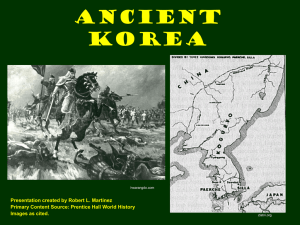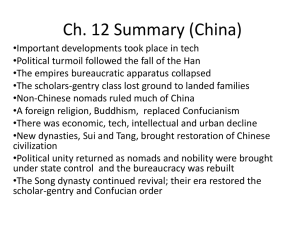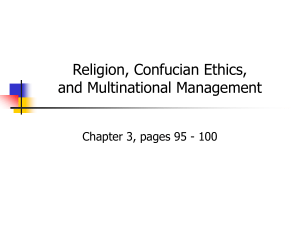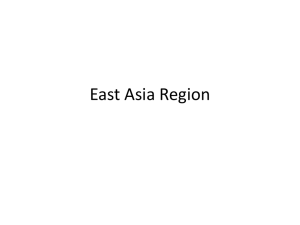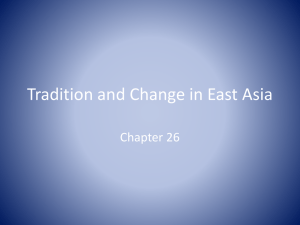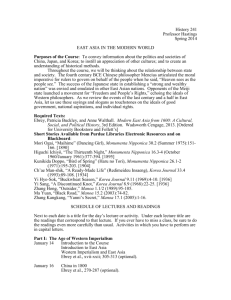Presentation - East
advertisement
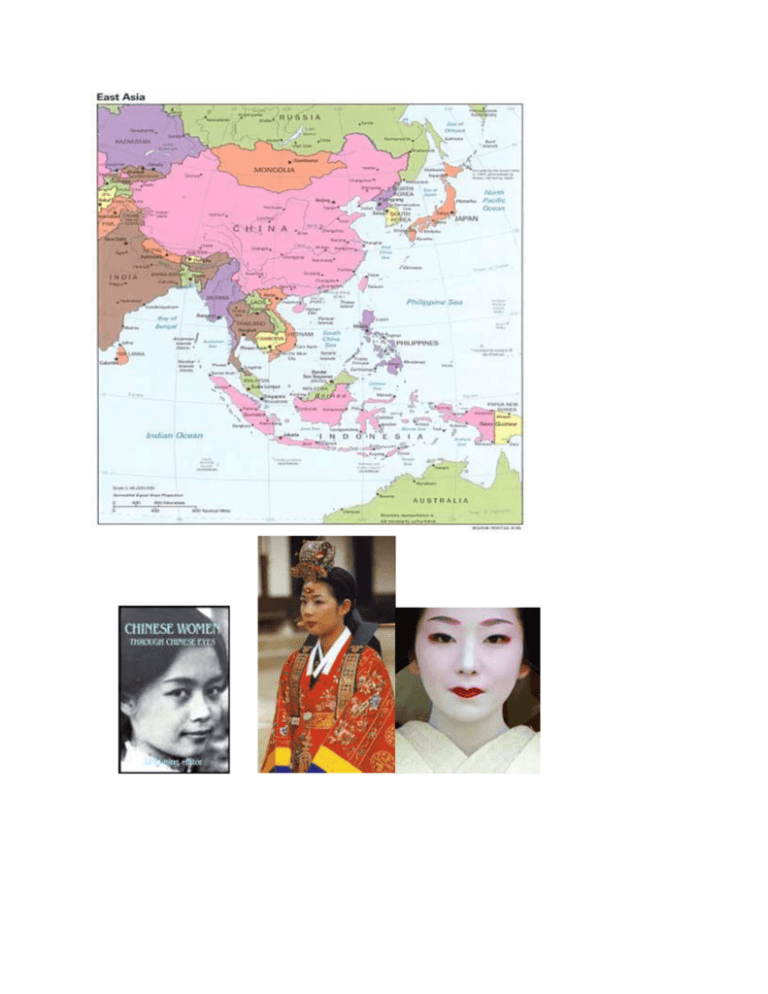
Understanding East Asia through gender The Big Picture: 1. Imperial period (-- 1800s): China, Korea and Japan will be treated as a region (East Asia) a. The Confucian Sphere: Social order and responsibility b. The Buddhist Influence: the Realm of Compassion Major themes: a. Virtues and morality b. Marriage and family relations c. Work, education, leisure d. Power and status e. Spirituality and aestheticism 2. Post-imperial period (after mid-1800): Certain issues emerge as major themes during this period: such as nationalism, modernization (and Westernization), feminist movement (suffrage) and revolution. During this period, more “micro description” will be added to further understand the unique and different developments within China, Korea, and Japan. Major themes: a. Nationalism, political and social movements Women’s roles in revolutions and social movements: such as the 1911 Revolution (China), March 1st Movement (Korea), the Suffrage Movement (China & Japan), the May Fourth Movement (China), the Communist Revolution (China), feminist movement (China, Korea, Japan), the Cultural Revolution (1966-76), b. Challenging the traditions Discourse on “New Women” Models: Western women (revolutionaries), Ibsen’s Nora (China) c. Individual identity, family, and marriage d. Political participation e. Work, education, leisure f. Women and war Themes and suggested reading/film Introduction “The Social Relation of the Sexes: the Methodological Implications of Women’s History” (Joan Kelly-Gadol) “East Asia: Common Ground and Regional Difference” (Rhoads Murphey) “Women in Asia” (Ramusack and Sievers) From the Antiquity to 1800s Pre-Confucius China: Chinese Mythology: An Introduction (Anne M. Birrell) Japan: “Ancient Japan: Female Gods…”, “Legends Concerning Shinto Deities” and “Birth of the Land” (Bingham) Sources of Japanese Tradition, Volume One: From Earliest Times to 1600 (vol. 1), (Wm. Theodore de de Bary et al.) Korea: Tan’gun The Confucian Sphere Confucianism: Confucius’ Analects Neo-Confucianism: Zhu Xi’s Learning To be a Sage (Gardner Trans.) The Ideal Womanhood and status of women: Pan Chao’s “Perfected Women” (Women’s virtues and exemplary women) “Two Women” and “The Interaction of Yin and Yang” (Ebrey: A Source book) Notable Women of China (Peterson) The position of woman in early China according to the Lieh nu chuan, "The biographies of eminent Chinese women" (O’Hara) “Separating the Sexes” (Ebrey: The Inner Quarters) “Widows and Remarriage in Ming and Early Qing China”, by Ann Waltner (Guisso and Johannesen) “New Year Sacrifice” (short story by Lu Xun. This piece can be used along with Waltner’s article to further discuss widow chastity in the late Qing period). Women, family, social structure: “Book of Filial Piety for Women Attributed to a Woman”, by Nee Zheng (Mann: Under Confucian Eyes) “Desire, danger, and the body: stories of women's virtue in late Ming China”, by Katherine Carlitz (Gilmartin) “Women, money, and class: Sima Guang and Song Neo-Confucian views on women” (Ebrey: Women and the Family in Chinese History) “Gender and sinology: shifting Western interpretations of footbinding, 1300-1890” (Ebrey: WFCH). “From daughter to daughter-in-law in the women's script of southern Hunan”, by Cathy Silber (Gilmartin) “Concubines in Song China” (Ebrey: WFCH). “Grooming a daughter for marriage: brides and wives in the mid-Qing period”, by Susan Mann (Brownell) “Propagating female virtues in Choson Korea”, by Martina Deuchler (Ko: Women and Confucian Cultures) “State indoctrination of filial piety in Tokugawa Japan: sons and daughters in the Official records of filial piety”, by Noriko Sugano (Ko: Women and Confucian Cultures) The Inner Quarters (Ebrey) Tang dynasty: the golden era for women? Empress Wu Zetian Women of the Tang Dynasty (Holdsworth) “Discipline and transformation: body and practice in the lives of Daoist holy women of Tang China”, by Suzanne E. Cahill (Ko: Women and Confucian Cultures) “Biography of the Daoist Siant Wang Fengxian”, by Du Guangting (Mann: Under Confucian Eyes) Images of women: painting, sculpture, short stories “The Ballad of Mulan” (http://www.chinapage.com/mulan.html) 5th C. “The Story of Yingying” (ASDP handout) “Qiuranke zhuan” (The story of the curly-bearded stranger” The Realm of Compassion Buddhism: Dharma, shangha, Mahayana Buddhism, Chan “Buddhism and Chinese women” (Stearns) “Biography of the Great Compassionate One of Xiangshan”, by Jiang Zhiqi (Mann: Under Confucian Eyes) *Teaching “spirituality”: a pedagogical article, “Women in the Teaching of Chinese Religions: Daughter/Wife/Mother or sage/Immortal/Bodhisattva?”, by Joseph A. Adler, in http://www2.kenyon.edu/Depts/Religion/Fac/Adler/Writings/Women. htm Women Living Zen: Japanese Soto Buddhist Nuns (Arai) Korean Buddhist Nuns and Laywomen (Cho) Work, Education and Leisure “Poems on Tea-Picking” (Mann: Under Confucian Eyes) “Drinking Wine and Reading ‘Encountering Sorrow’: A Reflection in Disguise, by Wu Zao (Mann: Under Confucian Eyes) “Women Writers of the Heian Age” & “The Status of Upper-Class Women of the Heian Age” (Bingham) “Norms and texts for women's education in Tokugawa Japan”, by Martha C. Tocco (Ko, Women and Confucian Cultures) “Women and the transmission of Confucian culture in Song China”, by Jian Zang (Ko: Women and Confucian Cultures) Teachers of the Inner Chambers: Women and Culture in seventeenth China (Ko) The Talented Women of the Zhang Family (Mann) Inner Quarters (Ebrey) From 1800s to present Nationalism, political and social movements China “Gender, political culture, and women's mobilization in the Chinese Nationalist revolution, 1924-1927”, by Christina K. Gilmartin (Gilmartin) “Women in the 1911 Revolution” (Ono, chapter 4) * Woman revolutionary: Qiu Jin (add primary source) “Between footbinding and nationhood” (Ono, chapter 2) “‘The truths I have learned’: nationalism, family reform, and male identity in China's New Culture Movement, 1915-1923”, by Susan L. Glosser (Brownell) Japan “Early debate on Women” (Shiever) “The quest for women's rights in turn-of-the-century Japan / Barbara Molony” (Molony) “Women in the popular rights movement (Shiever) Korea “Nationalism and Construction of Gender in Korea (Elaine Kim) Dangerous Women: Gender and Korean Nationalism (Kim) de Challenging the traditions China “The Family Prison”, “My Escape from hardship to a Free Life” (Li) A Woman Soldier's Own Story (Xie) “Casting off the shackles of the family” (Ono, chapter 5) Japan “Women and the Meiji Restoration – Education for Women” (Bingham) “Commodifying and engendering morality: self-cultivation and the construction of the "ideal woman" in 1920s mass women's magazines, Barbara Sato (Molony) “The women’s reform society”, “Women socialists” (Shievers) “Managing the Japanese household: the New Life Including discourse on ‘New Women’ and their models” (Molony) Naomi (a novel by Tanizaki) Korea “Kyonghui”, by Na Hye-sok (Kim Yung-hee) Individual identity, family, and marriage China: A Daughter of Han (Pruitt): The life of a working woman, from late 19th C to 1930s. Oral history. Old Madam Yin (Pruitt): The matriarch of the well-off Yin family faces changes and challenges at the turn of the century. Oral history. Wild Swans (Chang): an account of three women who witnessed China’s transformation from late 19th C to the Cultural Revolution. “The Status of Chinese Women in Marriage and the Family” (Tao) “The 1950 Marriage Law” (Ono) “Past, perfect or imperfect: changing images of the ideal wife”, by Harriet Evans (Brownell) “China's modernization and changes in the social status of rural women”, by Gao Xiaoxian (Gilmartin) “The origins of China's birth planning policy”, by Tyrene White (Gilmartin) “Population control and the four modernizations” (Ebrey: A Sourcebook) Japan: “Marriage and Family: Past and Present”, Kyoko Yoshizumi (Fujimura-Fanselow) The Waiting Years (novel by Enchi): a long suffering wife found not one but two concubines for her samurai husband. “Mystique of Motherhood: A Key to Understanding Social Change and Family Problems in Japan”, Masami Ohinata (Fujimura-Fanselow) “Care of the Elderly: A Women's Issue”, Takako Sodei (FujimuraFanselow) The Twilight Years (a novel by Ariyoshi). A woman, juggling between work and family, has to care for her ailing father-in-law. “Marriage, motherhood, and career management in a Japanese ‘counter Culture’, by Millie R. Creighton (Imamura) “Centering the household: the remaking of female maturity in Japan”, by Margaret Lock (Imamura) “Social relations as capital: the story of Yuriko”, by Robert J. Marra (Imamura) Haruko's World: A Japanese Farm Woman and Her Community (Bernstein) Political participation Japan: “Women legislators in the postwar Diet”, Sally Ann Hastings (Imamura) “Profiles of Two Assemblywomen”, “Aokage Takako: Housewife Turned Political Representative from Seikatsu Club Seikyo”, Naoko Sasakura, “Mitsui Mariko: An Avowed Feminist Assemblywoman”, Emiko Kaya (Fujimura-Franselow) “The Bluestockings” (Shievers) Work, education, leisure China “Sorrow of a Factory Worker” (Li): an account of factory worker in the 1920s “The rise of women workers” (Ono, chapter 6) – 1920-30 “Chinese women workers: the delicate balance between protection and equality”, by Margaret Y. K. Woo (Gilmartin) “Gender Inequality in Education in Rural China” (Tao) PRC Film: “No One Less” (A young girl assumes the responsibility to teach a group of children in rural China (PRC). Directed by Zhang Yimou) “Economic reform and the awakening of Chinese women's collective consciousness”, by Li Xiaojiang (Gilmartin). Japan “Made in Japan: Meiji women's education”, Martha Tocco (Molony) “Careers and commitment: Azumi's blue-collar women”, by Glenda S. Roberts (Imamura) “Challenges to Education for Girls and Women in Modern Japan: Past and Present”, Kimi Hara (Fujimura-Fanselow ) “Sexism and Gender Stereotyping in Schools”, Atsuko Kameda (Fujimura-Fanselow) “College Women Today: Options and Dilemmas”, by Kumiko Fujimura-Fanselow (Fujimura-Fanselow) “The textile workers” (Shievers) Korea “Sorting coal and pickling cabbage: Korean women in the Japanese mining industry, by W. Donald Smith (Molony) Women and War “Making ‘soldier’": the Imperial Army and the Japanese man in Meiji society and state”, Theodore F. Cook, Jr (Molony) The Comfort Women: Sexual Violence and Postcolonial Memory in Korea and Japan (Soh) “Re-membering the Korean Military Comfort Women” (Elaine Kim) “Womanhood, war, and empire: transmutations of ‘good wife, wise mother’ before 1931”, Kathleen Uno (Molony)


